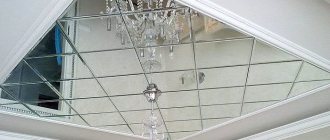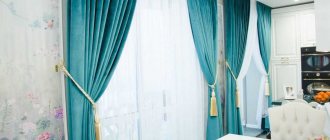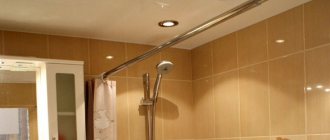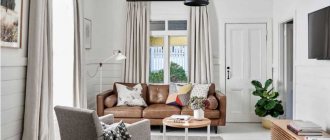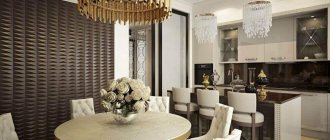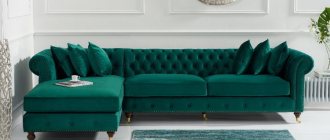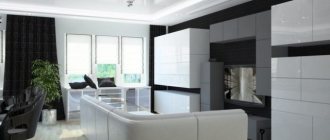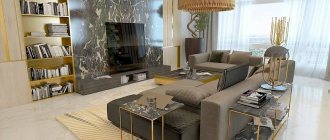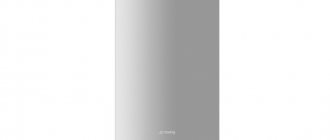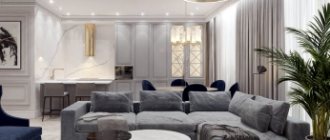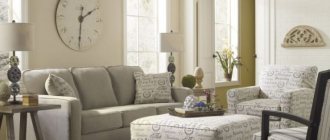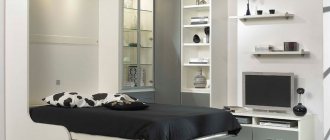Material prepared with the support of
Have you already decided that you are ready to “go into design”, but have not yet decided which one? The same type of tasks as a UI designer does not meet your ambitions, and are you ready to apply your skills in another design field?
In 2021, the stock platform Depositphotos, which has been helping some designers get work done faster and others earn money remotely for a decade, decided to analyze how many types of design professions there are.
What do a motion designer and a communications designer have in common? Will an architect understand a speculative designer? Let's explore 19 design trends together.
Architecture
Who to learn from - Ludwig Mies van der Rohe, Frank Lloyd Wright, Zaha Hadid
Just a few years ago, architecture was called the highest form of design. And it’s not surprising, because it’s hard to imagine something larger than a giant tower or bridge several tens of kilometers long.
Architecture aims to transform the environment so that it becomes both more usable and attractive. The functions of objects, the optimal technical solution (the building must be reliable, inexpensive and as simple as possible to construct), aesthetics - these are the three pillars of architecture.
Communication design
Communication design uses ready-made graphics, but its task is to make sure that important information comes to us in an understandable form. The result of specialists in this industry is saving the user’s time (usually we are talking about a network user, but the category is not limited to this) and performing a specific targeted action.
In general, communication design is the design of interactions between brands and individuals with target audiences on different platforms. It is a highly specialized industry that overlaps somewhat with PR, marketing and visual design in general.
Costume design
Who to learn from - Edith Head, Colleen Atwood, Alexandra Byrne
Costumes are made for theater and cinema, as well as specialized costume events (for example, celebrity theme parties, “masquerade” holidays like Halloween, festivals). The clients of these designers are also ateliers.
The difference between a costume designer's job and a traditional fashion designer's is the goal. Costume design is work on the visual image of a specific (specific and known in advance!) character, while the fashion designer sews clothes based on the needs of a wide audience.
The costume designer takes into account the image of the hero, the historical era and the peculiarities of filming (not all real materials look believable and recognizable in the frame).
Game design
Who to learn from - Sid Meier, Shigeru Miyamoto, John Romero
Game design is a top niche in the market not only for design, but also for digital products in general. The gaming sector generates several times more profit than smart homes, health applications and electronic banking. As for game designers, their profession is becoming more in demand every year, and the artistic discoveries made by them influence the design industry in general. For striking examples, we recommend taking a look at “Visual Trends 2020” from Depositphotos and find out that neon and futurism came into fashion in 2020 precisely from modern games.
However, game design, in addition to working on the aesthetics of the game universe, involves designing the gameplay. A game designer must have the skills of a screenwriter, artist and engineer. His task is to develop the players’ goals, establish the rules of the game world, and think through the sequence of tests.
Types of design
Industrial design
aesthetics originates . The primary place in the activity of an industrial designer is occupied by tools and mechanisms. This also includes machine tool and mechanical engineering products, vehicles and weapons.
Design of Architectural Environment
In modern design activities, the design of the architectural environment is becoming increasingly widespread, which is divided into interior and design of the external architectural environment .
Interior design includes the interiors and equipment of public spaces, residential spaces and the interiors of industrial buildings. Each of these types of spaces has its own characteristics and determines its own range of professional tasks and design methods for solving them.
Fashion design and accessories
More recently, in the 60s and 70s, fashion was divided into unique works of an artist-fashion designer, made individually, often to order; and the work of a fashion designer - mass-produced products of the clothing industry. Today, both unique “haute couture” works and mass-produced “prêt-a-porter” products are classified as fashion design. In part, this is a tribute to the fashion for design, but this is largely explained by the fact that the modern fashion industry is based on the basis of design formation, focused on the most modern technologies, materials, democracy and focusing on the general public.
Graphic design
The oldest and one of the most common areas of design activity is graphic design. This includes the art of designing a book, advertising and information brochure, booklet, poster, industrial graphics and packaging, developing labels and trademarks, brand names and typefaces, advertising products on billboards and facades in the city. Today, the traditional work of a graphic designer has been supplemented by work with complex graphic systems , which become the basis of the corporate identity of the enterprise, visual communications in interiors and the urban environment.
Computer design
Today, the computer has become firmly established in the designer’s work, becoming his indispensable companion and assistant in his work, facilitating the routine work of graphic design, freeing up his time for the creative search for an artistic idea. Modern computer programs not only reduce the time spent working on a project, but also significantly expand the palette of graphic and technical capabilities of the designer. For this purpose, today special design packages of artistic, graphic and engineering design programs have been created, including three-dimensional graphics and animation. Specialized design programs can sometimes replace an entire army of related specialists. They not only carry out accurate calculations, determining the shape of the product, suggesting the choice of certain structures and materials, but also allow simulating a future object in a variety of situations in three-dimensional images and in real time, not only creating virtual images of the shape of the designed object and checking its functioning , including in extreme conditions.
Art design
Design, in the process of its development, not only turned into an independent design and artistic culture, but also began to influence the formation in architecture, sculpture, and decorative and applied arts. The result of this interaction was avant-garde movements in art. A number of creative trends have appeared in design, aimed at synthesis with artistic and architectural form-building, under the general name “art design”. The works here, as in art, are often singular in nature, while the formation itself is fundamentally based on design philosophy : ergonomics of the product, focus on modern materials and technologies, fashion trends, etc.
Graphic design
Who to learn from - Paul Randt, Milton Glaser, Stefan Sagmeister
Graphic design is a type of design with which in 2020 designers in general are associated. A graphic designer works with visual elements, but his goal is not purely aesthetic. She is communicative. Effectively delivering a message from a brand or the author of the idea (in the case of an illustration) is its main task.
As a rule, a graphic designer is not limited in the means of work and the place where his work can appear. Depending on his specialization, he can create illustrations and collages, process photographs and complement them with graphic elements, create fonts or work with the brand communication palette. The main difference from an online communication designer is the direct creation of work.
Graphic design: marketing, advertising, branding
The skills of graphic designers are found almost everywhere: opening and closing titles of films, animation, television programs and commercials, corporate websites, computer screen layouts, newspapers, magazines, advertisements, posters, brand motifs and company logos, product packaging, road signs. etc. And it includes colors as well as typography, visual art and page and screen layout techniques, and product packaging materials. In fact, graphic design plays an important role when images, symbols or text are used to convey a visual message - from high-tech cockpit displays on military or commercial aircraft, to television commercials, travel brochures, trade catalogs and supermarket point-of-sale products.
Fashion design
Who to learn from - Coco Chanel, Yves Saint Laurent, Karl Lagerfeld
As we have already written, clothing design is significantly different from costume design, since in this case the designer’s efforts are not aimed at working with a specific character, who must make the right impression on a theater or television viewer. A fashion designer works on clothes that his target audience will wear. Clothes should be comfortable within the buyer's lifestyle, and also express a certain idea.
Information Design
Who to learn from - Paul Maixner, Edward Tufte, Jeff Raskin, Jeff
Information design is a type of graphic design, which is characterized by the fact that the designer is faced with the task of illustrating a large amount of information in such a way that an Internet user, book reader or television viewer quickly assimilates it. The requirements for this profession are skills in structuring information and understanding the specifics of its perception.
This area of design overlaps somewhat with communications design, but is much closer to the designer's “working tools”: the communications designer plans information campaigns and user interactions within products, and the information designer directly designs the visual objects for such communication. Here's an example of a Depositphotos infographic.
An information designer is hired to work on websites, information resources, and reference publications.
Interaction Design (IxD)
If you've just entered the field of digital design, you've probably at least once confused UI (user interface design), UX (user experience design in general) and the less popular IxD category, which involves working with interaction design. What does the user journey look like inside the product? What design element can become a guiding light for the user? How can I help him get the result he was looking for when he opened the application or website? It's all about IxD.
Interaction design is a branch of UX, so most designers and employers don't classify it as a separate category. However, it is not limited to the online sphere, and is also closely related to other types of design, including industrial and product.
Interior design
Who to learn from : Philippe Starck, Elsie Anderson de Wolfe, Tom Dixon
Due to the fact that most people are visual people, that is, most of the information about the world around them comes to them in the form of pictures and is perceived through their eyes, there are as many types of design as there are objects with which people interact. Those objects that we encounter most intensively form separate design universes around themselves and become overgrown with canons. Interior design is one example.
An interior designer must have engineering knowledge (but not necessarily as deep as an architect), knowledge of materials, cladding technologies, the current range of furniture and much more. In addition, he must have spatial imagination, understand the psychology of color and be able to visualize his vision of the “insides” of a house, office or other room in electronic form.
The task of the interior designer is to take into account and think through the lighting of the room, make it functional and comfortable.
Desire to become better
Continuing to talk about what design is, let’s pay attention to the furniture that is in our apartments, houses and offices. Few people think that it was once produced precisely to make our lives better, more comfortable and more beautiful.
For now, we are not talking about what types of certain furniture elements can be bought today, but let’s look directly at the objects on which we sit.
Once upon a time, people used only stools and benches. But a man appeared who wanted to have a more comfortable place to relax, and he created an upholstered chair. He had to first develop a structure that could support a person of any body weight, and then give it a certain appearance. Now it becomes easier to understand who a designer is. This is a person who simultaneously designs and ennobles his creations, which subsequently become useful and even indispensable for society.
Industrial and product design
Who to learn from - Marc Newson, Karim Rashid, Antonio Citterio
What is the difference between industrial and product design? These categories are really close to each other. At the same time, “product design” is often used as an analogue of industrial design in the production of physical products. But there is still a difference between them.
An industrial designer thinks through the physical characteristics of the future product and its functions. His task is to make the product simple to produce, but at the same time attractive, convenient and functional. He defines the product's appearance and then passes it on to an engineer who can come up with a new product design for the manufacturer.
Product design is more than just the external aspect of things. A product designer in the offline world takes control of the entire production cycle, and, accordingly, not only “draws” products, but also determines technologies and internal materials. In the digital realm, product designers are not involved in production, but are involved in UI, UX, and interaction design.
Main design categories
Etymology of the concept “design”
Design (English design) – plan, intent, plan, goal, intention, creative concept, project, drawing, calculation, construction; sketch, drawing, pattern, composition, art of composition, work of art; outline, sketch, mark, label, plan, make a mental plan, goal, make a preliminary sketch for constructing something. Design is a specific type of design activity that combines artistic and object-based creativity and scientifically based engineering practice in the field of industrial production.
Practice and theory of design
Design practice – artistic construction. Design theory - technical aesthetics.
Design item
The subject of design activity (what it is aimed at) is the creation of a harmonious, meaningful and expressive form of an object, which reflects the holistic meaning of its consumer value.
Design objects
The object of design can be a new technical industrial product (set, ensemble, complex, system) in almost any sphere of human activity.
Basic Design Method
Artistic and figurative modeling of a design object through compositional shaping. It is based on the results of an analysis of the utilitarian and aesthetic requests and preferences of certain groups of consumers, taking into account the situation and environment of use and perception of the object, as well as an analysis of the function of the object (as a means of objectively providing the corresponding needs), construction and finishing materials and manufacturing technology of products, determined by the capabilities specific enterprise.
Image
An ideal representation of an object, an artistic and figurative model created by the designer’s imagination.
Function
The role that the product should perform, as well as the semantic, symbolic and value roles of the thing.
Morphology
Structure, the structure of the form of a product, organized in accordance with its function, material and method of manufacture, embodying the designer's intention.
Technological form
Morphology embodied in the method of industrial production of a thing - a design object as a result of artistic interpretation of technology.
Aesthetic value
The special meaning of an object, revealed by a person in a situation of aesthetic perception, emotional, sensory experience and assessment of the degree of compliance of the object with the aesthetic ideal of the subject. In a broad sense, a designer is a person who deals with all the things of the material world that surround us.
The appearance of household items, their packaging and the store windows in which they are sold are all, to one degree or another, the fruit of design thought.
Printing designer (creator of any printed product from a simple business card to a billboard), architect-designer (developer of indoor interiors and outdoor advertising in the form of signs, shop windows, etc.), landscape designer (designer of the appearance of green spaces from flower beds to parks) and many others no longer use the old-fashioned methods of creating their projects with pencil and paper.
Technological progress has significantly improved and accelerated the process of moving from an idea to its immediate execution due to the variety of computer programs for working with images.
Motion design
Who to learn from - Yaniv Friedman, John Schlemmer, Mark Wheeler
Traditional graphic design tends to be static in nature. Motion design is the next stage of graphic design, as it involves working with a dynamic picture and applying the principles of filmmaking, animation and sound directing (in some cases). Like graphic design, motion design is not limited to any area of human life. We encounter it in advertising, on modern websites, in movies.
The motion designer must convey a message to the recipient (whether it is a statement that his customer’s product is worth attention or a call on the site user to delve into the article and remember something specific). A dynamic picture should be expressive and concise. Important skills for a motion designer are working with multimedia editors, understanding the basics of storytelling and sound design.
As a rule, a motion designer illustrates a certain concept using a moving image, rather than telling a story (like a cartoonist) from beginning to end. To reduce the cost of producing creative projects, they use stock videos.
Animation in Material Design
Unlike Apple, whose animation primarily serves an aesthetic function, Google focuses on UX and functionality. In their recommendations, animation is given much more attention, and at conferences, reports are devoted to them every now and then.
The main idea of animation in Material Design is to make the user interface expressive and easy to use. To do this, it must meet three principles.
Information content
The animation shows the spatial and hierarchical relationships between elements: what actions are available to the user and what will happen if he performs one of them.
Animation focuses attention on what's important and doesn't distract from the main action
Animation expresses the character, personality and style of each product.
Thus, using animation you can:
Show the user how elements are related to each other.
Show how to perform different actions.
Create a wow effect
Add attraction so that the user wants to interact with the product again.
And this is just the tip of the iceberg. Google really made the world reconsider its attitude towards animation and made it a full-fledged part of UX design. You can look for flaws in Material Design recommendations, but we think you shouldn’t completely ignore the importance of animation today.
Here's a funny note about one of the provisions of Material Design - that all objects coming out of the screen should accelerate
Lead developer John Schlemmer believes it doesn't matter where they stop.
"Google's Material Design guidelines seem to think that you should only accelerate when exiting the screen," Pascal D'Silva. Source
Thanks to Material Design, animation today is not just a spectacular addition to the design, but a full-fledged part of it. If you do it right, movement brings your interface to life and makes users love the interface. You can learn how to create cool animations in the Interface Animation course.
Course “Interface Animation”
You will be able to independently create any animation in interfaces and effectively convey the concept of projects to clients. We'll start with animating the simplest elements, such as icons, and move on to creating full-fledged cases and showreels.
- Live feedback from teachers
- Unlimited access to course materials
- Internship in partner companies
- Thesis project from a real customer
- Guaranteed employment in partner companies for graduates who have defended their theses
Multimedia design
Who to learn from - Mike Perry, Timothy Goodman, Stephen Harrington
The New York Times' multimedia projects were once the icon of design in the industry. The publication is still launching multimedia interactive stories online, which any subscriber can become a part of. Spectacular and engaging, they became a prototype of how product presentation and presentation of information in general could look. The idea of multimedia design is innovative and more effective ways of communication, which brings it closer to communication and UX design.
Modern multimedia design involves working with many components: graphic design, program code, script and interaction logic. Professionals in this field typically have technical skills and artistic vision, as well as a good imagination. They create multimedia products from scratch and take into account the ergonomics of the user interface and the customer’s commercial objectives.
Product Design
Product design is everything that surrounds us in everyday life - be it coffee cups, furniture, luxury goods or electronic gadgets. Today, more and more companies are looking for designers who can create an attractive, functional and commercially successful product. As a result, different approaches to teaching design in foreign universities are emerging.
Some schools introduce students to modern production and the market, others perceive the designer as an independent artist and try not to limit his creativity. Along with this, there are educational institutions that offer a more balanced curriculum. European design schools can specialize in textiles, services, cars, food, or offer separate courses as part of large universities.
An interior design graduate can find himself in a small company and work on an exclusive product, or go to the strategic department of a large company and do product testing. Many people choose to work as design consultants for manufacturing companies, and some open their own studios, relying on partnerships and contacts.
Istituto Marangoni is a legendary institute with a recently opened design school in Milan. All Marangoni product design programs focus on three things: functionality, aesthetic appeal and contemporary texture. During the training process, students draw up briefs, make drawings describing technical properties, study materials and production processes, research the market and create a design project. Each program is based on a project approach - from concept development to the finished product and its promotion.
Programs:
- Short courses: Italian product design, lighting, hotel interior design (2 - 3 weeks)
- Intensive Course: Interior Design (1 year)
- Three-year program: Product Design (3 years)
- Pre-Masters in Design (1 year)
- Master's degree: design of luxury goods for the home, design of boutiques, car interiors (1 year)
Software design
The most striking examples of software design are ready-made operating systems, websites and products aimed at “revitalizing” websites. The tasks of a software designer are radically different from what a graphic designer is used to working with. The results of its work can be presented in the format of flowcharts, ready-made programs or UX prototype
A software designer is more of an incendiary than an artist. He is interested in the logic of the product, algorithms that help the future user solve their problem. This designer interacts with programmers and graphic designers, often being above them according to the professional chain of command.
Sound design
Who to learn from - Ben Burtt, Jack Foley, Glenn Freemantle
The term “sound design” already speaks for itself. In this case, the specialist works not with visual signs, but with radial signs. This profession will be updated in 2021 through the widespread use of voice interfaces and innovations in the development of voice assistants. However, this is not the only niche in which a sound designer can shine.
Like images, sound evokes emotions and can set the tone of communication with the user. So, sound design involves this creation of sound elements. A sound designer develops an audio story by combining original or third-party samples. Required skills: musical education, knowledge of acoustic theory. The areas in which this specialist works are digital product design, film and television production, theater, radio and advertising.
Interactive Design
Interaction design is a relatively new direction in design. It is about how people interact with technology. Interaction design helps you look at objects and data differently, and solve technical issues in hardware, web design, and touch systems.
Interaction design has the user experience at its core, so it often requires research and rigorous testing. Objects for interactive design can be installations, smart devices, digital platforms. In the real world, mobile applications and interactive exhibition spaces are becoming increasingly popular. Hence the constant demand for user interface designers.
Students studying interaction design abroad can create their own startup through investors or crowdsourcing. The speed and success of this approach makes interaction design a unique industry in the current economic climate. Knowledge and skills in interaction design provide the opportunity to work at the forefront of modern technologies - in startups, as a freelancer, or for manufacturers.
Domus Academy in Milan offers a master's degree in Interaction Design. Training is based on workshops, seminars, project work, plus internships. Students learn to create a product, service or space that will interact with the human body or mind using technology. For those with experience in graphic design, architecture, web design or product design, this is an opportunity to pursue a career as a strategist, creative director or user interface designer in an overseas company.
- Study program : Master's in Interaction Design (1 year)
- Language of instruction : English
- Internship : 12 weeks. Work in a company (Adobe, Canon, Mattel, Nokia, Samsung, etc.), or a joint project with one of the companies on the Domus Academy campus
- Admission requirements : resume, portfolio, motivation letter, diploma of education, IELTS 5.0 certificate, 2 letters of recommendation
Interface design (UI)
Who to learn from - Joshua Porter, Whitney Hess, Ryan Singer
While a graphic designer works with both physical and digital objects, a UI specialist designs exclusively web interfaces. Roughly speaking, everything that we constantly encounter on our favorite sites (and that we hardly notice) - buttons, menus, typical page structure, tooltips and much more - is the product of the work of an interface designer.
The task of a UI designer is to ensure comfort and ease of interaction between the user and the software product. This specialist designs the design shell of products, which can then be filled with texts and illustrations, depending on its purpose.
A UI designer must consider user experience, from the point of view of which, the best interface is one that allows the user to solve their problem as quickly as possible, without outside help and without experiencing any stress. Due to the fact that a UI designer is sometimes also the one who thinks through the user’s path inside the product, a UI and UX specialist in a small project may turn out to be the same person.
Our house, cottage, office and the process of creating them
Perhaps most people first associate the word “design” with a certain type of interior. Today, room design options are divided into many varieties, which can be classified depending on the era, country, or simply the imagination of the creator. For example, in offices the classic style most often prevails, which, accordingly, originates from the era of classicism (nineteenth century).
Modern design is created in apartments, and it can resemble a spaceship, a nightclub and so on. As a rule, this option is characterized by a minimal amount of furniture, glass shelves and tables, a large number of mirrors and a monochrome color scheme. But any room (both work and home) can be made, say, in Japanese or French style. In the first case, it is enough to install a minimum of functional furniture in the room and add the appropriate paraphernalia. In the second, we select jardinieres, couches and sophisticated forged elements, after which your idea comes to life.
User Experience Design (UX Design)
Who to learn from - Andrew Caldwell, Erica Hall, John Maeda
A UX designer is responsible for designing the user experience inside a web product. Like all other designers, he must analyze the user's problem or task, and then immerse him in a visual environment that will help him find an effective solution (for example, clicking the right button and sending a request).
A UX designer also serves the interests of the company for which he works - often he needs to come up with a way to use the visual environment of a site or application to push the user to the decision the company needs (buy something else, leave a review, download a position).
This specialist does not so much create design prototypes as determine the logic of the web product and the strategy for interacting with the user. In addition to graphic skills, he must understand business analytics, user psychology and, of course, follow UX design trends.
Web design
Who to learn from - Ethan Marcotte, Lotta Nieminen, Chris Coyer
Web designer is a general title for professionals who work in digital technology and do not create physical objects. UI, UX, motion graphics, graphic designer who works with digital products, as well as IuD - all these people can call themselves web designers.
The task of a web designer is not only to “make sites beautiful,” but also to think about how the user will interact with their different elements, what he will feel, and what actions he will take after this contact. In addition to purely artistic decisions, the web designer is responsible for the structure of the site and standard elements of information design. Typically, this person is involved in the creation of the product at all stages (research, design, implementation of its ideas and studying the results after launch).
Basic types of design. Principles for the formation of new types of design
1 - A characteristic feature of each type of design.
2 — Tasks and directions of design.
3 — Design thinking of the designer.
4 - Subject and object of design in the leading areas of design creativity.
5 — Forms of serviced activities.
6 — Guidelines for creativity in the context of the main types of design.
7 - Morphological type of “carrier” of the design object of the main types of design.
Design is the artistic design and construction of aesthetic properties of the objective world around us.
Design is an organic unity of use and beauty, function and form.
Types of design:
· Architectural – these are the facades of buildings, the structures and layouts of buildings themselves, various other buildings, and their external decoration.
· Industrial – (industrial design, object design, industrial design) – a branch of design, an area of artistic and technical activity, the purpose of which is to determine the formal qualities of industrially produced products, namely, their structural and functional features and appearance.
· Engineering – carrying out comprehensive improvement of tools, devices, machines, machines.
· Technological – design and engineering support of technological projects at the enterprise. High-quality design work based on modern software.
· Automotive – artistic and design activity to create an original, functionally justified, time-resistant form of a car.
· Interior – these are interior design projects, as well as redevelopment of houses, offices and just apartments.
· Environmental – the process of creating expedient, comfortable and aesthetically valuable conditions for the implementation of everyday, social and industrial activities of a person.
· Ergo – artistic design of objects, the formation of which is determined primarily by the requirements of ergonomics. It involves an ergonomic pre-design study of any object before it is created and given shape.
· Decorating – designing artistic fabrics, drapes, tablecloths, carpets for industrial production.
· Graphic – industrial graphics (labels, product packaging, envelopes, postcards, etc.), various design and typography works. A special area of graphic design is book design, or its artistic construction, which consists of creating book design and the design of the book as a whole.
· Font - consists of searching for the artistic form of a font or font composition that best matches the type of graphic design and the meaning of the verbal message.
· Clothes – one of the areas of clothing design. Includes its modeling and design, thinking through convenience and compliance with fashion trends.
· Phyto – represents both the composition of individual volumetric or planar compositions from live or dried flowers and plants, as well as the holistic design of interiors with flowers, herbs, trees, etc.
Tasks and directions of design engineering:
At the stage of setting the task, the client presents an idea and main thoughts for its implementation. This is not enough to immediately begin implementing the project, namely: start developing graphic design, programming, setting up components, implementing interfaces and services.
All this work can be carried out only after completing design work, the result of which will be:
· analysis of a situation or object (technological, morphological, functional, artistic);
· interface prototypes tested in terms of user convenience, presentation of marketing information,
· valuable ideas to attract the target audience,
· description of user roles and behavior scenarios on the site,
· description of the company’s business processes related to the site,
· a detailed plan with priorities for the phased commissioning of services,
· assessment of the next stage of implementation and a schedule drawn up taking into account budget restrictions.
All this is done at the design stage, which will clearly reflect the system being developed and can be used at the implementation stage as a complete action plan for the working group.
The designer's design thinking has a certain specificity, which is characterized by the integrity of the vision of the objective world and the desire for its harmonization and aestheticization. Of greatest interest is the problem of determining the specifics of the designer’s design thinking in comparison with the consumer’s thinking.
And the problem here is not only that both have different worldviews - if a designer can understand the essence of a thing and its meaning as a “thing” in itself, then a consumer often has a “consumer” attitude towards a thing - it is also important how should the designer’s thinking be configured so that it coincides to some extent with the consumer’s thinking, so that they can understand each other.
The design of the entire process of activity and its implementation in practice can be carried out by one person - the subject of design.
Design objects are future means of achieving goals: structures, processes, systems. During design, they exist only in the designer’s imagination, preliminary descriptions, and models.
The morphological type of the design object of the main types of design is that which is unchanged in the object, which constitutes its main function, reflects the main purpose of the object. This can be different for each subject.
Advice for beginners
As many design varieties as there are in 2021, it looks like there will be even more in the future. With the development of digital technologies, new niches are emerging (from the design of voice interfaces to working with applications that perceive user gestures as commands), as well as design at the intersection of several specialties, including art, marketing, technology and analog production.
Our advice today is to start mastering any design specialty with the basics, which apply equally to industrial, information and web design. A strong theoretical basis is useful for every specialist and provides much-needed flexibility in the labor market.
Another brilliant idea is to study several related disciplines at once. The Depositphotos collection of stock images will help you get started with your practice, and numerous online courses that have become available in 2021 will help you acquire knowledge.
